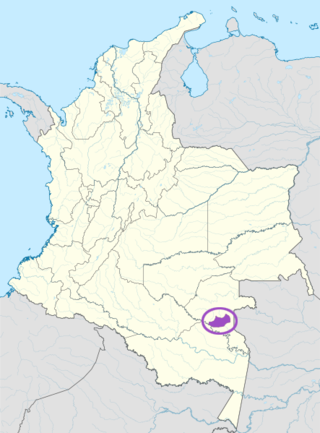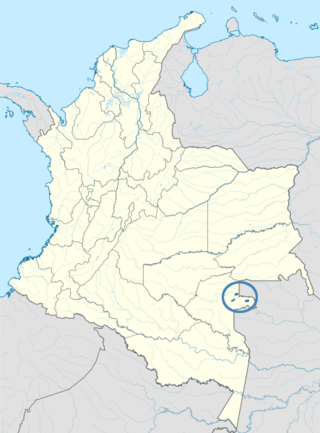Related Research Articles

Barbacoan is a language family spoken in Colombia and Ecuador.

Tucano, also Tukano or Tucana, endonym Dahseyé (Dasea), is a Tucanoan language spoken in Amazonas, Brazil and Colombia.

Tucanoan is a language family of Colombia, Brazil, Ecuador, and Peru.

The Nadahup languages, also known as Makú (Macú) or Vaupés–Japurá, form a small language family in Brazil, Colombia, and Venezuela. The name Makú is pejorative, being derived from an Arawakan word meaning "without speech". Nadahup is an acronym of the constituent languages.

Páez is a language of Colombia, spoken by the Páez people. Crevels (2011) estimates 60,000 speakers out of an ethnic population of 140,000.

Guahibo, the native language of the Guahibo people, is a Guahiban language that is spoken by about 23,006 people in Colombia and additional 8,428 in Venezuela. There is a 40% rate of monolingualism, and a 45% literacy rate.
The Cubeo are an ethnic group of the Vaupés Department (Colombia). Cubeo is a generic name that is used in local Spanish and appears in the literature in reference to a social and linguistic group. Although the term does not have any meaning in their language, the Cubeo refer to themselves by that name in interactions with others. There is no common native name, aside from referring to themselves as "people" (pâmiwâ) or, more precisely, "my people" (jiwa). An individual's social identification is based on his or her adscription to a mythical clan forebear whose name is used as an eponym.

The Nukak language is a language of uncertain classification, perhaps part of the macrofamily Puinave-Maku. It is very closely related to Kakwa.
Sirian or Sirians may refer to:

Barasana is a Tucanoan language of Colombia. It belongs to the Eastern branch of the Tucanoan family and is spoken in the Amazonian region by the Barasana people. The population of its native speakers is about 1,990 according to a census taken in 1993. Native speakers' tribes are spread out along the Pira Paraná River in Colombia and the banks of the Vaupés River Basin.

The Cacua language, also known as Kakua or Kakwa, is an indigenous language spoken by a few hundred people in Colombia and Brazil. There are many monolinguals, especially children. Apart from being close to or a dialect of Nukak, its classification is uncertain.

Guanano (Wanano), or Piratapuyo, is a Tucanoan language spoken in the northwest part of Amazonas in Brazil and in Vaupés in Colombia. It is spoken by two peoples, the Wanano and the Piratapuyo. They do not intermarry, but their speech is 75% lexically similar.
Saliba is an indigenous language of Eastern Colombia and Venezuela. Saliba was used by Jesuit missionaries in the 17th century to communicate with indigenous peoples of the Meta, Orinoco, and Vichada valleys. An 1856 watercolor by Manuel María Paz is an early depiction of the Saliva people in Casanare Province.

Siona is a Tucanoan language of Colombia and Ecuador. The language is essentially the same as Secoya, but speakers are ethnically distinct.

Kogi (Cogui), or Kagaba (Cágaba), is a Chibchan language of Colombia. The Kogi people are almost entirely monolingual, and maintain the only unconquered Andean civilization.

Siriano is a Tucanoan language of Colombia, with a few speakers in Brazil.
The Pira-tapuya, or variations like Pira-Tapuia, Piratapuyo, etc., or Tapuya for short, are an indigenous people of the Amazon regions. They live along the Vaupés River in Colombia and in the state of Amazonas, Brazil.
Ecuadorian Siona is a spoken language by the Siona people of Ecuador, and can be considered a dialect or variety of a larger Baicoca-Siecoca, or Siona-Secoya, language cluster. Ecuadorian Siona is part of the Western Tukanoan language family.
Kãkwã, Cacua or Bará-maku is an indigenous people living in northwestern Amazonia, between Vaupés, Querarí and Papuri rivers, in Colombia, close to the border with Brazil, within Vaupés indigenous Resguardo. The Kãkwã are approximately 250 people, who speak their own language, which is part of the Macu family and is closely related to the Nukak language.
The Bará are an indigenous people originating from the northwest of the Amazon rainforest, which lives in the headwaters of the Tiquié River, above the village of Trinidad and in the upper Igarapé Inambú and the upper Colorado and Lobo.
References
- Ibáñez Fonseca, Rodrigo (1972) Los Siriano. Bogotá: University of the Andes.
- Nagler, Christine, and Beverly Brandrup (1979) "Fonología del Siriano"; Sistemas fonológicos de idiomas colombianos IV: 101-126. ILV. Lomalinda: Editorial Townsend.
- Ojeda, Elvira; Sussy Orozco, and Ruth Monterroso (1984) "Los Sirianos"; Ellis de Walter, Leah B. and Linda Criswell (eds.) Estudiemos las culturas indígenas de Colombia: 170-171. ILV. Lomalinda: Editorial Townsend.